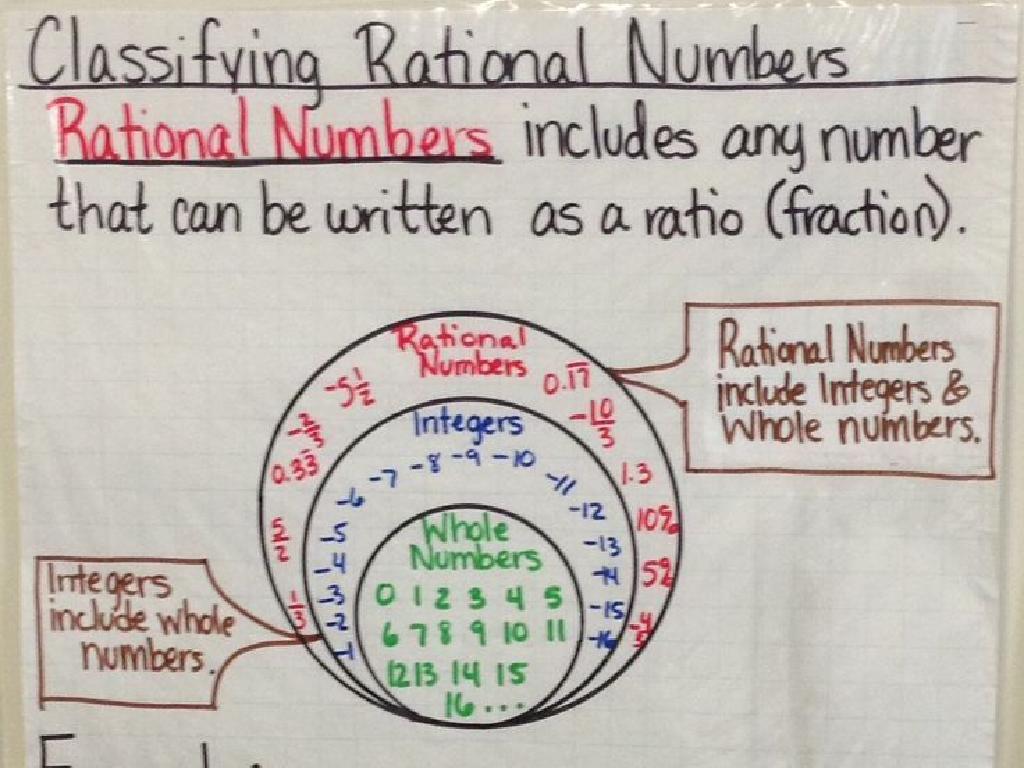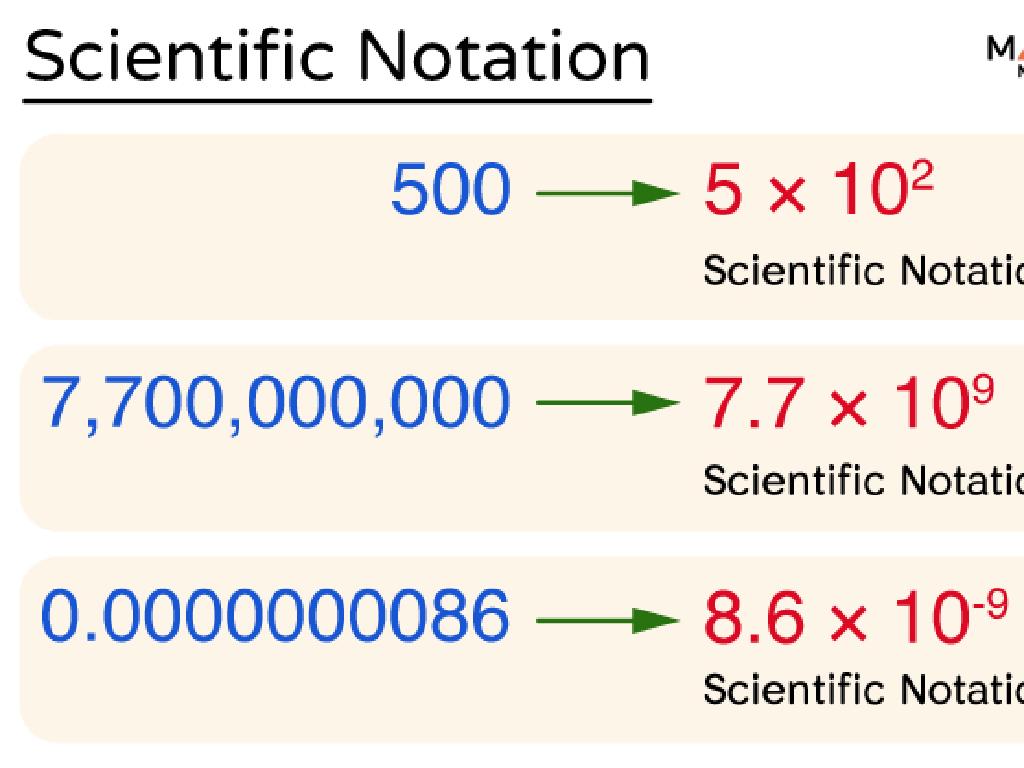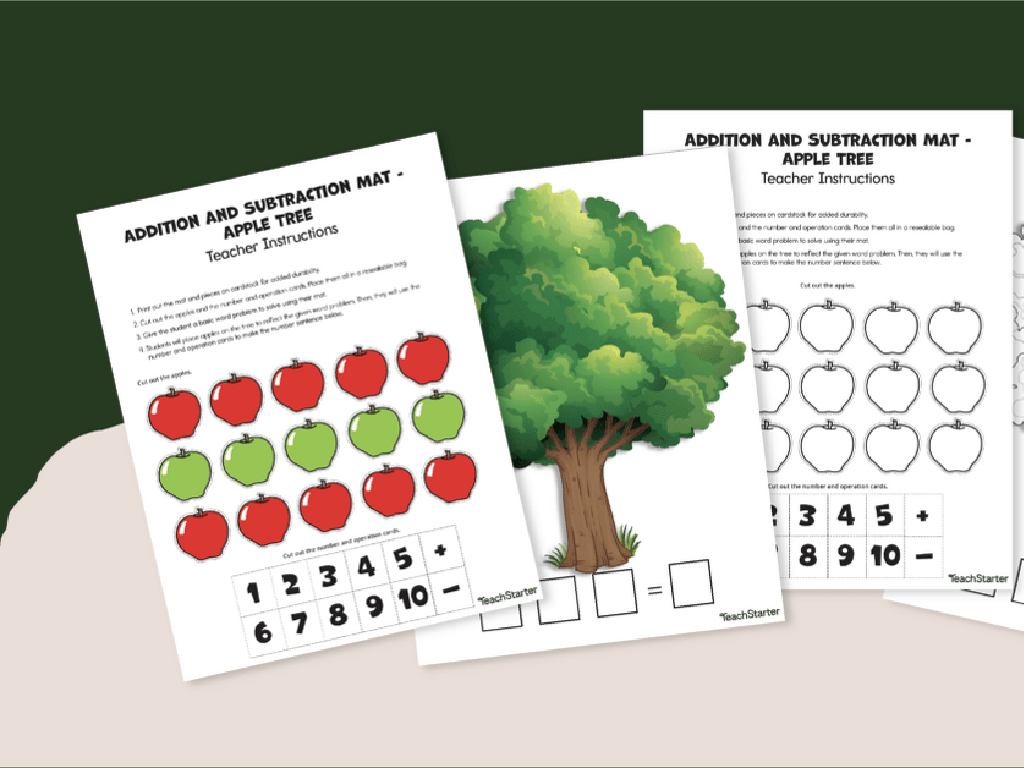Evaluate Multi-Variable Expressions
Subject: Math
Grade: Sixth grade
Topic: Expressions
Please LOG IN to download the presentation. Access is available to registered users only.
View More Content
Introduction to Expressions
– Mathematics: A Language
– Math uses symbols and numbers like words to communicate ideas.
– Defining Expressions
– Expressions are combinations of numbers, variables, and operations.
– Categories of Expressions
– Simple, complex, and multi-variable are some expression types.
– Evaluating Multi-variable Expressions
– Use given values for variables to find expression’s value.
|
This slide introduces the concept of expressions in mathematics, likening math to a language with its own set of ‘words’ symbols, numbers, and operations. Expressions are the ‘sentences’ of this language, formed by combining these elements. We’ll discuss different types of expressions, focusing on multi-variable expressions, which involve more than one unknown value. Students will learn to evaluate these expressions by substituting numbers for variables. It’s crucial to ensure students understand the role of each component in an expression and how they come together to convey meaning. Provide examples for each type of expression and practice evaluating them with the class.
Understanding Variables in Expressions
– Define a variable in math
– A variable is a symbol for a number we don’t know yet.
– Letters as number placeholders
– Instead of ‘some number’, we use letters like x, y, or z.
– Variables in simple expressions
– For instance, in 2x + 3, x is a variable representing a number.
– Practice with real examples
– Let’s try evaluating expressions like 3a + 4b when a=2 and b=3.
|
This slide introduces the concept of variables within the context of mathematical expressions. A variable is explained as a symbol, typically a letter, that stands in for an unknown number. Students will learn that these letters are not just arbitrary choices but are placeholders that allow us to work with numbers in a general way. By providing examples of simple expressions, students can see how variables function within math problems. The slide encourages active learning by prompting students to practice with real examples, reinforcing the concept that variables can represent any number. This foundational understanding is crucial for evaluating multi-variable expressions as they progress in algebra.
Evaluating Expressions with One Variable
– Substitute values for variables
– Replace x with 5 in 3x to evaluate
– Follow the Order of Operations
– Remember PEMDAS: Parentheses, Exponents, Multiplication/Division, Addition/Subtraction
– Practice Example: 3x for x=5
– Calculate 3*5 to find the value of 3x
– Understand the evaluation process
|
This slide introduces students to the concept of evaluating algebraic expressions with one variable. Start by explaining the substitution of values for variables, which is replacing the variable with a given number. Emphasize the importance of following the order of operations, known by the acronym PEMDAS, to correctly evaluate expressions. Work through the practice example by substituting x with 5 in the expression 3x, and then multiply to find the value. This will help students understand the step-by-step process of evaluating expressions. Encourage students to practice with additional examples and to always check their work by following the order of operations.
Evaluating Expressions with Two Variables
– Understanding multi-variable expressions
– An expression with two different variables, like x and y
– Steps to solve multi-variable problems
– 1. Identify variables 2. Substitute values 3. Perform operations
– Practice: Evaluate 2x + 3y for x=3, y=4
– Substitute x with 3 and y with 4, then calculate
|
This slide introduces students to the concept of multi-variable expressions, which are mathematical phrases that include more than one variable. Begin by explaining what variables are and how they can represent numbers in expressions. Then, outline the steps to evaluate these expressions: identifying the variables, substituting them with given values, and performing the arithmetic operations in the correct order. Use the practice example to demonstrate the process: replace x with 3 and y with 4 in the expression 2x + 3y to get 2(3) + 3(4), which simplifies to 6 + 12, and finally to 18. Encourage students to work through this example and provide additional problems for them to practice.
Evaluating Complex Expressions
– Combine like terms in expressions
– Add or subtract terms with the same variable
– Evaluate expressions with exponents
– Apply the power rule for exponents
– Practice example with variables
– Let’s solve 4x^2 + 2y for x=2, y=3
|
This slide introduces students to the concept of evaluating complex multi-variable expressions. Start by explaining the process of combining like terms, which involves adding or subtracting terms that have the same variable to simplify the expression. Next, discuss how to handle exponents in expressions, emphasizing the power rule. For the practice example, guide students through substituting the given values for x and y into the expression 4x^2 + 2y and solving it step by step. This will help them understand how to approach and solve expressions with multiple variables and exponents. Encourage students to work through additional examples for practice.
Expression Evaluation Challenge
– Pair up for expression solving
– Share solutions and methods
– Discuss effective strategies
– Did you use substitution, or another method?
– Reflect on the learning process
– Think about how different approaches helped.
|
This class activity is designed to foster collaborative learning and critical thinking. Students will pair up to work through a set of multi-variable expressions, encouraging teamwork and peer teaching. After solving the expressions, each pair will share their solutions and the methods they used with the class, promoting communication skills. The group discussion will focus on the strategies employed by different pairs, allowing students to learn from each other’s approaches. As a teacher, facilitate the discussion by asking guiding questions and ensure that each student is engaged. Provide 4-5 different sets of expressions for variety and to cater to different skill levels. Encourage students to reflect on their learning process and understand that there are multiple ways to approach problem-solving in mathematics.
Wrapping Up: Multi-Variable Expressions
– Review of expression evaluation
– Practice makes perfect
– Regular practice is key to mastering math skills
– Homework: Worksheet completion
– Solve the provided problems on multi-variable expressions
– Keep questions for next class
– Note any difficulties to discuss in the next session
|
As we conclude today’s lesson on evaluating multi-variable expressions, it’s crucial to emphasize the importance of practice. The homework worksheet is designed to reinforce the concepts learned in class and to provide students with the opportunity to apply these skills independently. Encourage students to attempt all problems and remind them that struggling with complex expressions is a part of the learning process. They should come to the next class prepared to ask questions and share their solutions. This will help them gain confidence in their ability to work with expressions involving more than one variable.






